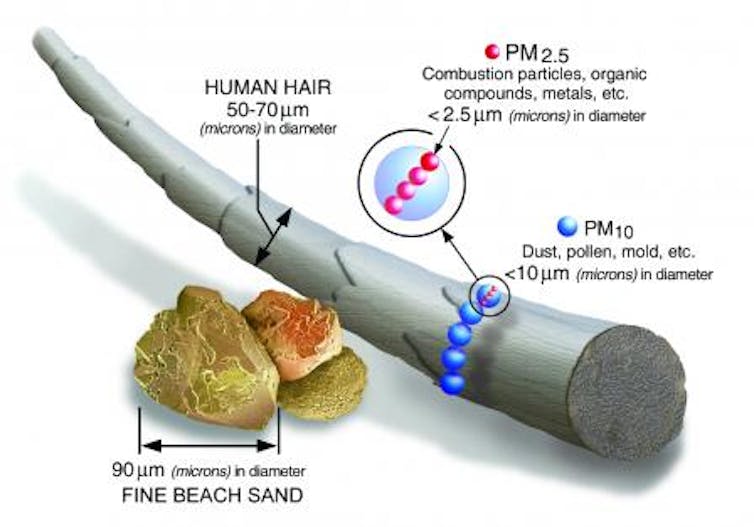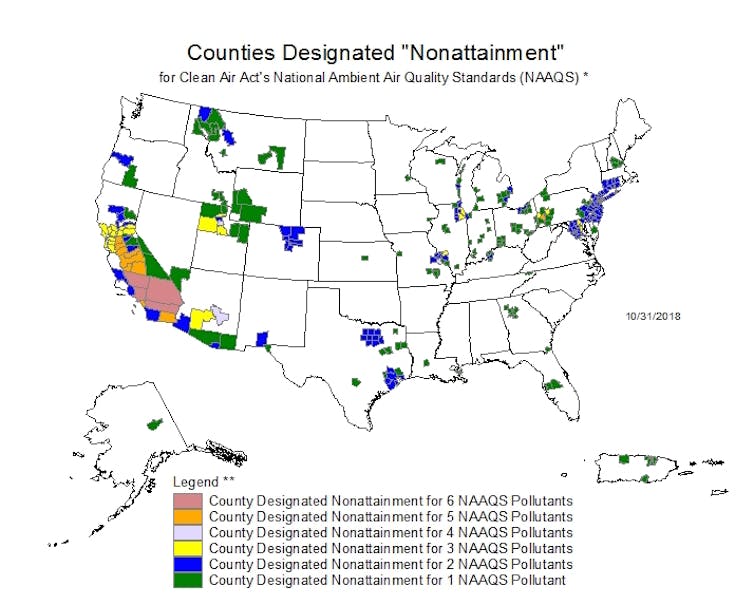Fine particle air pollution is a public health emergency hiding in plain sight
- Written by Douglas Brugge, Professor of Public Health and Community Medicine, Tufts University
Ambient air pollution is the largest environmental health problem in the United States and in the world more generally[1]. Fine particulate matter smaller than 2.5 millionths of a meter, known as PM2.5, was the fifth-leading cause of death in the world in 2015, factoring in approximately 4.1 million global deaths annually[2]. In the United States, PM2.5 contributed to about 88,000 deaths in 2015[3] – more than diabetes, influenza, kidney disease or suicide[4].
Current evidence suggests that PM2.5 alone causes more deaths and illnesses than all other environmental exposures combined[5]. For that reason, one of us (Douglas Brugge) recently wrote a book[6] to try to spread the word to the broader public.
Developed countries have made progress in reducing particulate air pollution in recent decades, but much remains to be done to further reduce this hazard. And the situation has gotten dramatically worse in many developing countries – most notably, China[7] and India[8], which have industrialized faster and on vaster scales than ever seen before. According to the World Health Organization, more than 90 percent of the world’s children[9] breathe air so polluted it threatens their health and development.
As environmental health specialists, we believe the problem of fine particulate air pollution deserves much more attention, including in the United States. New research is connecting PM2.5 exposure to an alarming array of health effects. At the same time, the Trump administration’s efforts to support the fossil fuel industry[10] could increase these emissions when the goal should be further reducing them.
 The average human hair is about 70 micrometers in diameter – 30 times larger than the largest fine particle.
EPA[11]
The average human hair is about 70 micrometers in diameter – 30 times larger than the largest fine particle.
EPA[11]
Where there’s smoke …
Particulate matter is produced mainly by burning things. In the United States, the majority of PM2.5 emissions come from industrial activities, motor vehicles, cooking and fuel combustion, often including wood[12]. There is a similar suite of sources in developing countries, but often with more industrial production and more burning of solid fuels in homes.
Wildfires[13] are also an important and growing source, and winds can transport wildfire emissions hundreds of miles from fire regions. In August 2018, environmental regulators in Michigan reported that fine particles from wildfires burning in California were impacting their state’s air quality[14].
Most deaths and many illnesses caused by particulate air pollution are cardiovascular – mainly heart attacks and strokes[15]. Obviously, air pollution affects the lungs because it enters them as we breathe. But once PM enters the lungs, it causes an inflammatory response that sends signals throughout the body, much as a bacterial infection would. Additionally, the smallest particles and fragments of larger particles can leave the lungs and travel through the blood.
Emerging research continues to expand the boundaries of health impacts from PM2.5 exposure. To us, the most notable new concern is that it appears to affect brain development[16] and has adverse cognitive impacts[17]. The smallest particles can even travel directly from the nose into the brain via the olfactory nerve.
There is growing evidence that PM2.5, as well as even smaller particles called ultrafine particles, affect children’s central nervous systems[18]. They also can accelerate the pace of cognitive decline in adults[19] and increase the risk in susceptible adults of developing Alzheimer’s disease[20].
PM2.5 has received much of the research and policy attention in recent years, but other types of particles also raise concerns. Ultrafines are less studied than PM2.5 and are not yet considered in risk estimates or air pollution regulations. Coarse PM, which is larger and typically comes from physical processes like tire and brake wear, may also pose health risks.
Coverage of an air quality alert in Delhi and neighboring cities, Nov. 5, 2018.Regulatory push and pull
The progress that developed countries have made in addressing air pollution, especially PM, demonstrates that regulation works. Before the U.S. Environmental Protection Agency was established in 1970, air quality in Los Angeles, New York and other major U.S. cities bore a striking resemblance to Beijing and Delhi today. Increasingly stringent air pollution regulations enacted since then have protected public health and undoubtedly saved millions of lives.
But it wasn’t easy. The first regulatory limits on PM2.5 were proposed in the 1990s, after two important studies[21] showed that it had major health impacts[22]. But industry pushback was fierce[23], and included accusations that the science behind the studies was flawed or even fraudulent. Ultimately federal regulations were enacted, and follow-up studies and reanalysis confirmed the original findings[24].
Now the Trump administration is working to reduce the role of science in shaping air pollution policy[25] and reverse regulatory decisions by the Obama administration. One new appointee to the EPA’s Science Advisory Board[26], Robert Phalen[27], a professor of medicine at the University of California, Irvine, is known for asserting that modern air is actually too clean for optimal health[28], even though the empirical evidence does not support this argument.
 U.S. counties failing to meet national standards for at least one of six major air pollutants regulated under the Clean Air Act: PM2.5, PM10, sulfur dioxide, carbon monoxide, nitrogen dioxide and eight-hour ozone.
EPA[29]
U.S. counties failing to meet national standards for at least one of six major air pollutants regulated under the Clean Air Act: PM2.5, PM10, sulfur dioxide, carbon monoxide, nitrogen dioxide and eight-hour ozone.
EPA[29]
On Oct. 11, 2018, EPA Administrator Andrew Wheeler disbanded a critical air pollution science advisory group[30] that dealt specifically with PM regulation. Critics called this an effort to limit the role that current scientific evidence plays in establishing national air quality standards that will protect public health with an adequate margin of safety, as required under the Clean Air Act.
Opponents of regulating PM2.5 in the 1990s at least acknowledged that science had a role to play, although they tried to discredit studies that supported the case for regulation. The new approach seems to be to try to cut scientific evidence out of the process entirely.
No time for complacency
In late October 2018, the World Health Organization convened a special conference on global air pollution and health[31]. The agency’s heightened interest appears to be motivated by risk estimates that show air pollution to be a concern of similar magnitude to more traditional public health targets, such as diet and physical activity.
Conferees endorsed a goal of reducing global deaths from air pollution by two-thirds by 2030[32]. This is a highly aspirational target, but it may focus renewed attention on strategies such as reducing economic barriers that make it hard to deploy pollution control technologies in developing countries.
In any case, past and current research clearly show that now is not the time to move away from regulating air pollution that arises largely from burning fossil fuels, in the United States or abroad.
References
- ^ the world more generally (www.healthdata.org)
- ^ 4.1 million global deaths annually (www.healthdata.org)
- ^ 88,000 deaths in 2015 (doi.org)
- ^ more than diabetes, influenza, kidney disease or suicide (www.cdc.gov)
- ^ all other environmental exposures combined (www.healthdata.org)
- ^ wrote a book (www.springer.com)
- ^ China (dx.doi.org)
- ^ India (www.washingtonpost.com)
- ^ more than 90 percent of the world’s children (www.who.int)
- ^ support the fossil fuel industry (theconversation.com)
- ^ EPA (www.epa.gov)
- ^ industrial activities, motor vehicles, cooking and fuel combustion, often including wood (www.epa.gov)
- ^ Wildfires (dx.doi.org)
- ^ impacting their state’s air quality (www.michiganradio.org)
- ^ heart attacks and strokes (www.healthdata.org)
- ^ affect brain development (dx.doi.org)
- ^ adverse cognitive impacts (www.ncbi.nlm.nih.gov)
- ^ affect children’s central nervous systems (www.ncbi.nlm.nih.gov)
- ^ accelerate the pace of cognitive decline in adults (dx.doi.org)
- ^ developing Alzheimer’s disease (theconversation.com)
- ^ two important studies (dx.doi.org)
- ^ major health impacts (dx.doi.org)
- ^ industry pushback was fierce (www.hsph.harvard.edu)
- ^ confirmed the original findings (www.healtheffects.org)
- ^ reduce the role of science in shaping air pollution policy (theconversation.com)
- ^ EPA’s Science Advisory Board (yosemite.epa.gov)
- ^ Robert Phalen (www.faculty.uci.edu)
- ^ modern air is actually too clean for optimal health (www.theguardian.com)
- ^ EPA (www3.epa.gov)
- ^ disbanded a critical air pollution science advisory group (dx.doi.org)
- ^ global air pollution and health (www.who.int)
- ^ reducing global deaths from air pollution by two-thirds by 2030 (www.who.int)
Authors: Douglas Brugge, Professor of Public Health and Community Medicine, Tufts University

